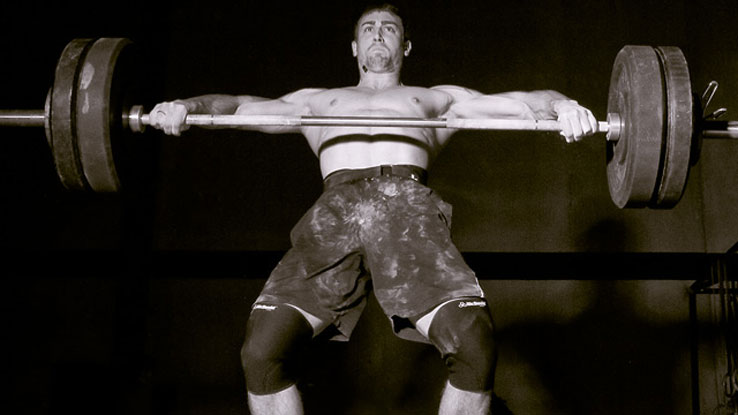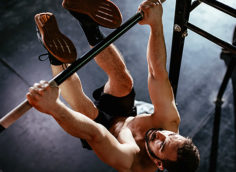Here's what you need to know...
- Including an "explosive" day along with your bodybuilding days can burn fat and make you more mobile and athletic.
- One or two Olympic lifts, some basic plyometrics, and short sprints are really all you need to reap the benefits.
- Use lighter loads and think of the muscles contracting as hard as they can. Look for improvements in mobility, range of motion, and speed.
Rarely do I see someone with tons of muscle mass and high levels of mobility, explosiveness, and overall athleticism. But it's not impossible. By incorporating a little athletic-based training for explosiveness and general athleticism, you can build a bigger, stronger body that moves as good as it looks.
Including an athletic or explosive day or two alongside your base workouts like legs, back, or chest is one option. There are several benefits to including these days:
- Encourage more mobility from a tight body.
- Help to burn fat from utilization of fast twitch muscle fibers and increased metabolic demand.
- Help build muscle. Your type II fibers will be recruited more efficiently if they're trained specifically by this kind of training.
- Be less prone to injury with all the above in check. That means you won't pull a hamstring during a casual run on the beach.
So what exercises should you do? Contrary to popular belief, you don't have to go out and buy ropes, heavy tires, and a sled. I've narrowed your needs down to a short list.
A properly executed full Olympic lift places the most athletic demand on the body from a weight training perspective, especially once the load is heavy. The speed and power required to project a bar to shoulder level, drop into a front squat with the load properly balanced, and then propel that load overhead is something no other weight training exercise can match.
In addition, if your mobility or flexibility really sucks, it'll definitely make itself known as a weak link at some point.
However, you don't have to be a competing Olympic lifter to have respectable technique. Here are some practical tips to accelerate your learning curve.
- Start with snatches. Due to mobility restrictions, many lifters find it easier to learn the snatch before the clean and jerk. A simple exercise to build power and get used to the full snatch is the power snatch followed by overhead squat. But deep overhead squatting is tough, so don't be discouraged if you have to drop the weight significantly.
Below is a video of me doing it with 185 pounds. In the video, you'll notice the high catch position. Catching in the power position like this is an easy way to build confidence before transitioning to the full snatch.
Of course, the clean and jerk movements should also be trained. Don't be surprised if both your deadlift and upper back strength improves after training the full clean and jerk.
To learn to be even faster and more explosive, try decreasing your pulling space and catching the weight in the power stance. This can also be a lower back-saver, especially if you were deadlifting the day before or planning to the following day.
The first video is a full clean and jerk from the floor, and the second video shows the same weight from 14-inch blocks. As you can see, you need to be much faster with less pulling space.
Needless to say, the Olympic lifts in some form should be a part of your training. Not only will they help develop strength and power, they'll make you more mobile once you learn to do them well. That translates into deeper squats, more flexibility, and a newly raised ceiling on muscle building potential.
Sprint workouts are frequently peppered into lifters' conditioning programs when they want to lean out. However, the average Joe's "balls to the wall" technique often disappoints. Sprinting properly at high velocities will encourage:
- Psoas firing. This is important, as few strength training exercises actually encourage concentric firing of the psoas muscle. Strong hip flexors make for a much more stable pelvic girdle and can transfer into stronger squats and overall core stability.
- Real core training. The core's main function is to resist unwanted forces that come externally. Maintaining an upright stable torso while running as fast as possible is much more challenging than most "core routines."
- High threshold motor units. With sprints, fast twitchers get a chance to be truly active, especially during short sprints. That translates into the potential for them to work much more efficiently in the weight room. Furthermore, you're doing a form of cardio that doesn't sacrifice any of the muscle you've worked so hard to put on.
I recommend short sprints (under 10 seconds in length) over long sprints as you won't be quite as sore the next day.
Plyometrics don't only involve box jump variations. You can also incorporate bounding drills, single-leg runs, double-leg broad jumps, and on-the-spot plyometric versions of a basic exercise like a squat or push-up.
These help create newfound explosiveness while charging up the nervous system for what lies ahead. They're best suited to the beginning of a workout (after warming up, of course), since they're unloaded and dynamic in nature.
So how do we align these methods with a typical bodybuilding-style workout routine? Here's an example that introduces one or two "explosive" days into your bodybuilding-friendly work week.
Day 1 – Back Workout
Day 2 – Explosive Workout A
| Exercise | Sets | Reps | |
|---|---|---|---|
| A | Barbell Power Snatch – Overhead Squat | 5 | 2 |
| Ramping sets of 2 reps each, then 5 work sets of 2 reps. | |||
| B | Clean and Jerk from Blocks | 5 | 1 |
| Ramping sets of 2 reps each, then 5 work sets of 1 rep. | |||
| C | Plyometric Bounding | 5 | 20/strides |
| D | Standing Broad Jump | 4 | 8/jumps |
| Jump continuously, try not to spend any time on the ground once you land. | |||
| E | Sprinting | 8 | 50 m. |
| Sprint to 90% of your max speed. Focus on a high knee drive and stable torso while pumping the arms hard. | |||
Day 3 – Chest Workout
Day 4 – Leg Workout
Day 5 – Shoulders Workout
Day 6 – Explosive Workout B
| Exercise | Sets | Reps | |
|---|---|---|---|
| A | Barbell Full Clean | 5 | 2 |
| Ramping sets of 1 rep each, then 5 work sets of 2 reps. | |||
| B | Plyometric Push-up | 6 | max |
| Max rep is the amount of reps required before you're no longer powerfully leaving the ground with each push-up. | |||
| C | Broad Jump with Static Hold | 6 | 10 |
| Hold a deep squat for 3 seconds (be strict), then explode as high and as far forward as possible. Stick the landing in a full squat and hold for 3 more seconds. If the impact bothers your knees, modify by doing them straight up and landing in the same spot. | |||
| D | Sprinting | 3 | 120 m. |
This is not a program for "athletes." It's simply a program for meatheads looking to shift their focus so they can spend a couple of days each week developing more athletic capacity.
That said, don't try to be a hero. Focus on your performance under lighter loads, and think of the muscles contracting as hard and as fast as they can. Look for improvements in mobility, range of motion, and speed.
Still wondering how you could possibly sacrifice your beloved arms day to do stuff that may be completely foreign to you? Remember that no matter what you read, hear, or do, the body is a machine that works best as an entire unit.
That means making that unit run more efficiently and move better will be half the battle towards unlocking gains and busting through plateaus that have been plaguing both your strength and size development.
Plus it doesn't hurt in the quest for fat loss. Sounds like a win-win to me.





